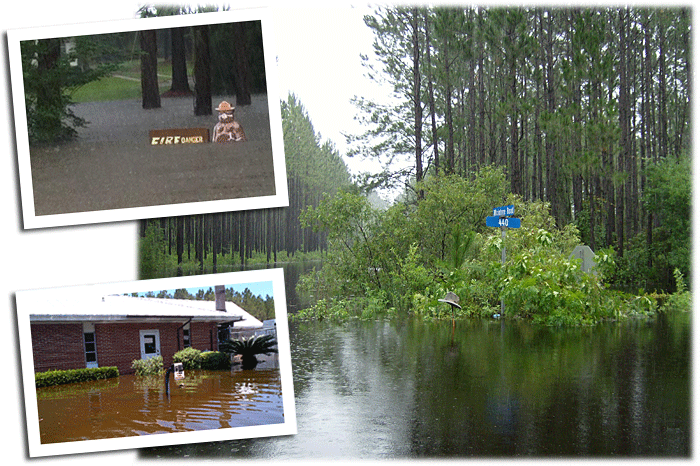Caption: On June 27, 2012, the flooding in some areas of Florida was 3 to 4 feet deep, as shown in the photos here.
| Assessing the potential devastation to Florida agriculture |
In late June, Tropical Storm Debby stalled over Apalachicola Bay for more than 24 hours, unloading several inches of rain on Florida’s Panhandle and unleashing 45-mile-per-hour winds that extended more than 230 miles from the center of the storm. During Tropical Storm Debby, the Florida Department of Agriculture and Consumer Services activated its emergency response functions to assist Floridians, particularly agricultural producers, in weathering the storm and managing its aftermath.
Due to more than 18 inches of flooding in some areas, road closures were a serious concern. Working with poultry, dairy, and other agriculture industry representatives, the department relayed challenges faced by feed and milk trucks trying to access farms in affected areas, especially in Suwannee County, to county emergency management officials and developed a plan. The department then communicated information to groups, like IFAS, Florida Feed Association, Farm Bureau, Southeast Milk, and the Florida Cattlemen’s Association, to keep farmers and producers informed throughout the state. During the storm, the department also supported counties by sheltering and caring for displaced animals in Madison and Suwannee Counties through its Mobile Animal Response Emergency (MARE) trailer, which contains cages and supplies for animals.
In the wake of Tropical Storm Debby, the department is working closely with the U.S. Department of Agriculture’s (USDA) Farm Service Agency (FSA) to quantify agricultural losses and determine which of Florida’s counties meet the threshold for a primary Secretarial Disaster Declaration from the USDA. The excessive rainfall, flooding, flash flooding, high winds, lightning and multiple tornadoes the storm inflicted caused extensive damage to both the quality and quantity of many of our crops, as well as to the grazing pastures critical to Florida’s livestock producers. Early estimates indicate that 158,000 acres of farmland (64,000 acres of cropland) were subject to six or more inches of rain. As a result, cattle and horses have been moved to higher ground and some dairy cattle are being kept in loafing barns to ensure they are not cut off from milking areas because of high water.
I’ve informed Governor Rick Scott of the potential devastation to Florida agriculture as a result of Tropical Storm Debby. Once the damage assessment is complete, I will work with Governor Scott to request that U.S. Agriculture Secretary Tom Vilsack designate parts of Florida as primary natural disaster areas so that Florida’s agricultural producers can access much-needed assistance.
The Florida Department of Agriculture and Consumer Services works to assist and protect all facets of the agriculture industry throughout Florida, particularly in times of crises. For more information about our emergency response efforts, visit www.FreshFromFlorida.com.
CREDIT
story by Commissioner Adam H. Putnam
Adam H. Putnam of Bartow is commissioner of the Florida Department of Agriculture and Consumer Services.

